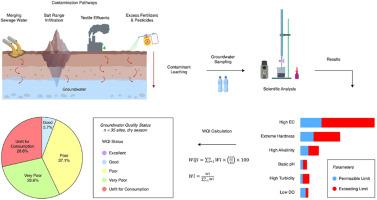Physicochemical investigation of groundwater within the confinement of Sargodha city and remediation pathways for contaminants
IF 4.1
3区 地球科学
Q2 GEOSCIENCES, MULTIDISCIPLINARY
引用次数: 0
Abstract
Groundwater contamination in Sargodha city is a significant concern, with organic, inorganic, radioactive, and biological contaminants that pose critical challenges to public health and water security. The study focuses on investigating the physicochemical properties of the groundwater in Sargodha city to identify and address pollutants affecting the groundwater quality, covering a large spatial region for accurate assessment. For this study, groundwater was collected from 35 locations in Sargodha city in the dry season. The analysis of which displayed extreme mineralization, with high electrical conductivity, EC (mean 11,052.68 μS/cm) and extreme total hardness, TH (mean 757.40 mg/L), critical oxygen depletion with dissolved oxygen, DO (mean 2.87 mg/L) and highly alkaline conditions due to high pH (mean 7.54) and elevated total alkalinity, TA (mean 202.66 mg/L), and large amount of organic matter evident from the coexisting high turbidity (mean 3.74 NTU). The water quality index (WQI) evaluation reveals nuanced groundwater quality risks, with 28.6 % of the water unsuitable for drinking, 28.6 % in very poor condition, 37.1 % in poor condition, and only the remaining 5.7 % in good condition; however, no groundwater has an excellent quality status. This deterioration pattern of groundwater quality strongly correlates with urbanization and industrial zones, indicating clear anthropogenic contamination routes. The water quality issues in the city need to be further researched to understand the root cause, and decisive actions could be taken to solve them.

萨戈达市区地下水的理化调查及污染物的修复途径
萨戈达市的地下水污染是一个重大问题,有机、无机、放射性和生物污染物对公共卫生和水安全构成严重挑战。本研究重点研究了萨戈达市地下水的物理化学性质,以识别和解决影响地下水质量的污染物,覆盖了大的空间区域,可以进行准确的评估。在这项研究中,在旱季从萨戈达市的35个地点收集了地下水。分析结果显示,其矿化程度高,电导率高,EC(平均值11052.68 μS/cm),总硬度高,TH(平均值757.40 mg/L),溶解氧临界耗氧,DO(平均值2.87 mg/L),高pH值(平均值7.54)和总碱度升高导致的高碱性条件,TA(平均值202.66 mg/L),以及共存的高浊度(平均值3.74 NTU)所显示的大量有机物。水质指数(WQI)评价显示地下水水质风险存在细微差别,28.6%的水质不适宜饮用,28.6%的水质极差,37.1%的水质极差,仅剩下5.7%的水质良好;然而,没有一种地下水的质量状况是优异的。这种地下水质量的恶化模式与城市化和工业区密切相关,表明了明确的人为污染途径。城市的水质问题需要进一步研究,以了解根本原因,并采取果断行动来解决它们。
本文章由计算机程序翻译,如有差异,请以英文原文为准。
求助全文
约1分钟内获得全文
求助全文
来源期刊

Physics and Chemistry of the Earth
地学-地球科学综合
CiteScore
5.40
自引率
2.70%
发文量
176
审稿时长
31.6 weeks
期刊介绍:
Physics and Chemistry of the Earth is an international interdisciplinary journal for the rapid publication of collections of refereed communications in separate thematic issues, either stemming from scientific meetings, or, especially compiled for the occasion. There is no restriction on the length of articles published in the journal. Physics and Chemistry of the Earth incorporates the separate Parts A, B and C which existed until the end of 2001.
Please note: the Editors are unable to consider submissions that are not invited or linked to a thematic issue. Please do not submit unsolicited papers.
The journal covers the following subject areas:
-Solid Earth and Geodesy:
(geology, geochemistry, tectonophysics, seismology, volcanology, palaeomagnetism and rock magnetism, electromagnetism and potential fields, marine and environmental geosciences as well as geodesy).
-Hydrology, Oceans and Atmosphere:
(hydrology and water resources research, engineering and management, oceanography and oceanic chemistry, shelf, sea, lake and river sciences, meteorology and atmospheric sciences incl. chemistry as well as climatology and glaciology).
-Solar-Terrestrial and Planetary Science:
(solar, heliospheric and solar-planetary sciences, geology, geophysics and atmospheric sciences of planets, satellites and small bodies as well as cosmochemistry and exobiology).
 求助内容:
求助内容: 应助结果提醒方式:
应助结果提醒方式:


